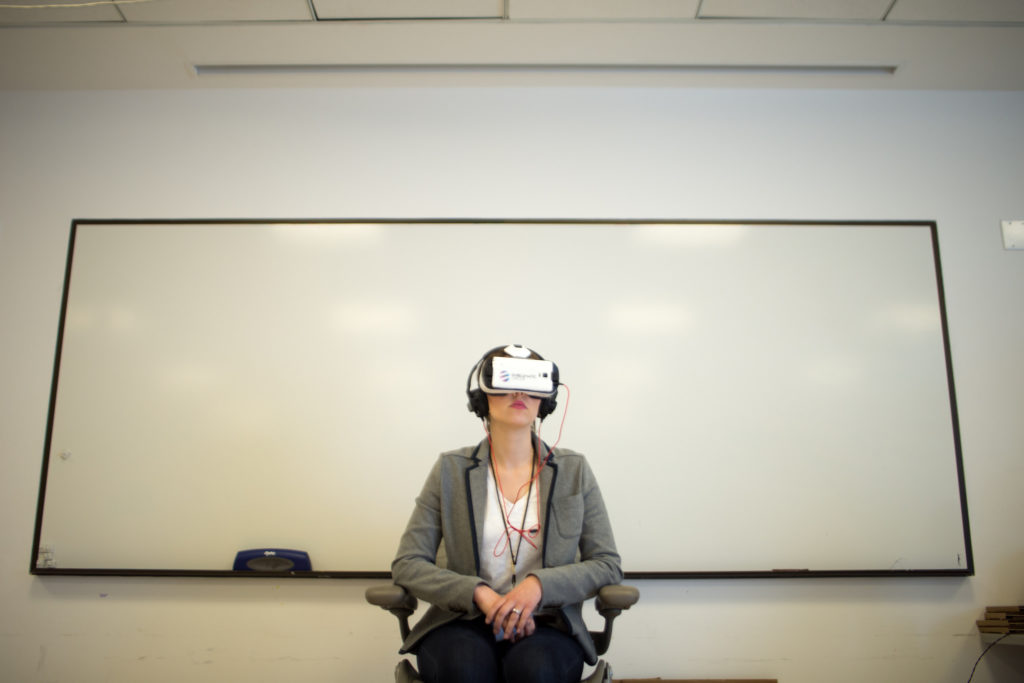April 17, 2015 | Virtual Reality
New storytelling platform — virtual reality — popular at ISOJ
Attendees at the International Symposium on Online Journalism (ISOJ) formed long lines Friday to test virtual reality (VR) as a storytelling platform.
Ray Soto, creative lead of virtual reality product for Gannett Digital, helps news organizations create VR content for their sites. He was at ISOJ to demonstrate VR as a tool media outlets may want to embrace.
To tell the stories of family farmers in Iowa, Gannett’s The Des Moines Register created a 3D environment using a video game engine so that readers could walk around a 100-year-old farm. At certain points in the farm, readers can watch 360-degree videos that elaborate on the journalist’s reporting.
The spherical video was made using a camera array. In order to create the 3D environment, news organizations need the help of a 3D or gaming developer. The whole project took about two months to finish, Soto said.
“That was a fully-rendered out 3D environment you could walk through,” said Soto. “It’s walking through, feeling fully immersed, exploring this farm, but at the same time having those full spherical videos that you could watch. So it’s very similar to long-form storytelling.”
Readers who are lucky enough to own an Oculus Rift virtual reality headset can get the full 3D experience, but users can experience a similar effect with existing software on their computers.
After the Harvest of Change project, Soto said he was challenged to produce and publish content more quickly for breaking news or sporting events.
That led to a process using a panoramic 360-degree camera to create photo and video, along with a template that news organizations can use to create a virtual experience. It lacks 3D assets, but can be pushed to publication more quickly.
The Cincinnati Enquirer used this process in its coverage of the Cincinnati Reds baseball team to take readers onto the field with the players.
The Emblematic Group, a virtual reality company, showed two systems that can be used for “immersive journalism.”

In the first, users sit in a chair and wear headpiece holding a cellphone and pair of headphones. They are placed into different scenarios, such as the 2012 shooting of Trayvon Martin in Florida.
The viewer first sees surveillance footage showing Martin inside a 7-11 store. The screen then cuts to a 3D recreation of the apartment complex where he was confronted and later shot. The viewer sees a recreation of George Zimmerman in his white truck and Martin in his black hoodie while listening to the 911 call between Zimmerman and the dispatcher. The remainder of the 3D recreation is from the assumed point of view of three residents who called 911; we hear their conversations punctuated by gunshots in the background.
The second system was similarly developed, but allows the user to walk around and explore the recreated environment. In this scenario, the viewer is dropped onto a street during a bombing in Aleppo, Syria, during the civil war. They are then taken to a refugee camp and a food bank.
“It’s the next medium of content and you can create a sense of presence and a sense of empathy that is not attainable with any other medium of content out there,” said Eren Aksu, sales director and business development lead with the Emblematic Group.
This 16th annual edition of ISOJ, which continues Saturday at the Blanton Museum of Art, on the campus of the University of Texas at Austin, is being livestreamed in English here, and in Spanish here.

